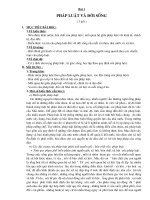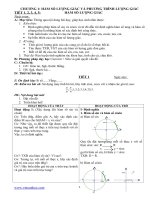Bài giảng 2. Measuring Development (Chỉ có bản tiếng Anh)
Bạn đang xem bản rút gọn của tài liệu. Xem và tải ngay bản đầy đủ của tài liệu tại đây (660.08 KB, 18 trang )
<span class='text_page_counter'>(1)</span><div class='page_container' data-page=1></div>
<span class='text_page_counter'>(2)</span><div class='page_container' data-page=2>
Class Schedule
▪ Definition of development is not clear – then, how do we measure development? (or
‘growth’)
▪ Economic development – traditional measure of development, is this legitimate?
▪ Alternatives? – human-centered development index, promise and challenges
</div>
<span class='text_page_counter'>(3)</span><div class='page_container' data-page=3>
How to Measure ‘Development – Big
Trend
Traditional
measurement
Economic
data
<i>GNP or GDP</i>
<i>(Acquisition of wealth)</i>
Modern 20th
Century
Process of
Change
<i>Greater social justice, </i>
<i>quality of life</i>
<i>Qualitative</i>
<i>Quantitative Data</i>
Later 20th
Century
Greening of
Development
</div>
<span class='text_page_counter'>(4)</span><div class='page_container' data-page=4>
Why Do We Need To Measure?
▪ If we have ability to
measure the wide range of
development factors, we
can look at development
over time.
▪ Shown ‘level’ of ‘process’
of development.
▪ Encourage development –
what is missing, less
effective, etc.
Economic
Growth &
Technology
<i>Life Expectancy</i>
<i>Environment</i>
<i>Personal Wealth</i>
<i>Mobility</i>
<i>Freedom of Speech</i>
<i>Democracy</i>
<i>Social Justice</i>
<i>Quality of Life</i>
<i>Education</i>
</div>
<span class='text_page_counter'>(5)</span><div class='page_container' data-page=5>
Defining & Measuring Development
▪ In order to review the various ways of measuring ‘development’ → necessary to
define ‘development.’
▪ Definition – “The process of change operating over time.”
▪ Traditionally, development = ‘_______________’
▪ Economic data such as GDP growth rate, GDP per capital, etc.
▪ Under this conceptualization, traditional emphasis was on ‘______________’ of
poorer countries to enable them to catch up the gap with richer countries.
Economic Growth
</div>
<span class='text_page_counter'>(6)</span><div class='page_container' data-page=6>
Traditional Measures
▪ The most widely used measure for international comparison is the Gross National Product
per capita.
▪ GNP – total value of a countries’ economic production in a particular year
▪ GNP includes;
✓ Production of food/goods
✓ Provision of services
✓ Profits from overseas investments
✓ Money earned in the country by foreign people and foreign business.
</div>
<span class='text_page_counter'>(7)</span><div class='page_container' data-page=7>
Is GDP / GNP Growth Legitimate?
▪ Whilst the measure is extremely widely used, the use of money units (e.g. GNP, GDP)
to assess development has a number of problems.
▪ Benefit: Provides an overall picture of the countries’ economy (easier comparison).
▪ Benefit to policy makers and central banks? – Enable them to judge whether the
economy is shrinking or expanding, whether it needs a boost or restraint, whether
recession or inflation is coming.
But, almost universal agreement that GDP
alone is an imperfect metric for growth and
</div>
<span class='text_page_counter'>(8)</span><div class='page_container' data-page=8>
Discuss What GDP Cannot Capture
1. Real Value: The real value of the unit of currency for each country will change
significantly over short periods of time.
2. International Exchange Rates: do not necessarily reflect the relative purchasing
power of one currency against another.
3. Some countries have different definitions of national income (e.g. former planned
economies, like Russia, China).
</div>
<span class='text_page_counter'>(9)</span><div class='page_container' data-page=9></div>
<span class='text_page_counter'>(10)</span><div class='page_container' data-page=10>
But What are Really Missing?
▪ Materialistic measure – the production of goods, rather than on health, education,
and the environment. Biased view on ‘development.’
▪ May fail to capture the complex trade-offs between present and future, work and
leisure, ‘good’ and ‘bad’ growth.
▪ Cannot fully keep pace with the changing nature of economic activity – 4th <sub>industrial </sub>
revolution / quality and diversity of goods and services / depletion of resources, etc.
</div>
<span class='text_page_counter'>(11)</span><div class='page_container' data-page=11>
Kuznets
Simon Kuznets said (1934) puts:
“The welfare of a nation can scarcely be inferred from a measure
of national income. If the GDP is up why America is down?
</div>
<span class='text_page_counter'>(12)</span><div class='page_container' data-page=12>
Alternative, Complementary Measures
▪ The aggregate and per capita real incomes are not sufficient indicators of economic
development – a multivariate concept having many dimensions.
▪ Rise of social indicators – e.g. life expectancy, state of prevalent health, housing
status, nutritional condition, educational achievement, etc.
▪ Welfare of the people – difficult to measure.
Education
<i>Primary, Secondary, Tertiary & Higher</i>
Literacy Rates
Gross Enrolment Ratio
<i>Below 40% -- Poor (Natarajan, 1990)</i>
</div>
<span class='text_page_counter'>(13)</span><div class='page_container' data-page=13>
Access to
Drinking
Water /
Sanitation
<i>Inherent capacity of individual</i>
Disease
Life expectancy
Infrastructure
Etc.
<i>Reflect education, income, disease, water, etc.</i>
Health
Life expectancy at birth
Maternal Mortality
<i>Sufficient nutrition, health, etc. (HDI)</i>
<i>Child, women, hospital, sanitation</i>
</div>
<span class='text_page_counter'>(14)</span><div class='page_container' data-page=14>
Composite Index of Development
Trend: Development is measured in terms of composite indices of development that
account for different aspect of development. For example,
Physical Quality of Life
Index
Morris D. Morris
(1979)
Literacy, life
expectancy, and infant
mortality to measure
quality of life
Human Development
Index
Mahbubul Haq (1990)
Life Expectancy
Education
Per Capita Income
Global
Multidimensional
Poverty Index
Oxford & UN (2010)
Severe Deprivations
Education
Health and Living
</div>
<span class='text_page_counter'>(15)</span><div class='page_container' data-page=15></div>
<span class='text_page_counter'>(16)</span><div class='page_container' data-page=16>
Human Development Index
<i>▪ “To shift the focus of development economics from national income accounting to </i>
<i>people-centered policies” (Mahbubul-Haq, 1990).</i>
▪ Whether people are able to ‘be’ and ‘do’ desirable things in life (‘<i>capability approach</i>’)
▪ Calculated by taking three indicators: a. Longevity, b. Educational attainment, c. decent
standard of living.
▪ Sensational – widely viewed, and some governments used HDI to allocate resources (e.g.
Argentina, Brazil, Mexico, Egypt, etc.).
</div>
<span class='text_page_counter'>(17)</span><div class='page_container' data-page=17>
The OECD Well-Being Framework
Current Well-Being
[Populations averages and differences across groups]
Quality of Life
- Health status
- Work-life balance
- Education and skills
- Social connections
- Civic engagement
- Environmental Quality
- Personal security
- Subjective Well-being
Material Condition
- Income and wealth
- Jobs and earnings
- Housing
Resources for Future Well-Being
Sustaining Well-Being over time through Preserving
National Capital Human Capital
Economic Capital Social Capital
<i>Source: OECD (2018), Beyond GDP </i>Link
<i>What is the </i>
<i>meaning of </i>
<i>having better </i>
<i>measurement </i>
<i>for </i>
</div>
<span class='text_page_counter'>(18)</span><div class='page_container' data-page=18>
Vietnam and HDI
Vietnam HDI
0.477 (1990) to
0.683 (2015)
</div>
<!--links-->
<a href=' /> Bài giảng thống kê xây dựng cơ bản
- 23
- 1
- 2








